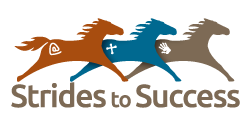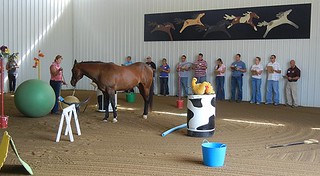Blair McKissock was kind enough to answer some questions about her work with Strides to Success.

How much of your day/week is related to horses?
60+ hours of what I do every week is related to horses. This includes direct service with clients, the marketing and training program coordination, proctoring online coursework and facilitating training programs.
What is it exactly that you do?
I am the director of education for Strides to Success in Indiana. My job is to implement and coordinate special programs. I write the programs up to be published as curricula and resources for the industry, and facilitate the HorseWork Education training program. I also coordinate the online courses, provide direct service in equine assisted learning and therapy.
In this field of work, is it possible to be a full time professional and earning a liveable income?
Yes!! If you create a diverse stream of income. Also, collaborate with other organizations in your area, do your homework on the program planning process to accurately match your programs to the needs in your community. And if you are passionate enough to persevere through the hard stuff.
What are the general steps taken to be employed in such a role?
Certification through a credible program, experience and skill with both horses and humans, good partnership with a barn or barn of your own, desire to never stop learning!
Favourite horse memory?
There are so many it’s hard to choose. This one in particular was the foundation for the Equiyo-yoga on horseback book so is it special to me.
I had been working with a client with multiple sclerosis. She would get on her horse and proceed to canter lap after lap. She was very high energy but would never talk about her diminishing ability to maintain balance and her decrease in strength as the disease progresses.
Every lesson it would take her a long time to mellow out and encourage the horse to walk. You could tell that the horse was clearly reflecting the excess energy and whirlwind that must have been in the rider’s head. One day we spent time focusing on breath work and talking about her situation before she even got on.
After she mounted we moved through some basic yogic breathing and posture work so she could feel the horse move under her. She began to talk about her fear related to her decline. As she talked, the horse took a huge breath and immediately the horse calmly walked. Once she acknowledged that she kept herself busy so she intentionally didn’t notice or pay attention to what was going on in her body, things changed between her and the horse. It was amazing to see!

Future goals?
My goal is to continue doing what I am doing but take it to the next level. My professional goal is to continue supporting the industry through committee work with professional organizations. The aim is to develop guidelines so that as we move forward, we will be on the right track to protect the integrity of what we do. This will help keep both clients and horses safe.
I also want to create more curriculum and resources that have been on the back burner for a while. As well as take this work and teach more on a regular basis at the University level to help establish academic programs for training and certification.
Currently I teach online courses through Strides to Success including an online therapeutic riding apprentice course. I want to expand those to make continuing education as affordable and accessible as possible. My hope is that things are set up for the next generation of equine professionals to take the reins and go further than we have dreamed of.
Best thing about your sport/profession?
The best thing is that it is just the beginning. We are learning more and more every day about how interaction between horses and humans can be so beneficial to both. There is so much more to learn and explore. And lots of opportunity for people to jump into this industry and help blaze trails! This can also present quite a challenge to people who are just starting out and are trying to figure out how to get the training and experience they need to do the work safely and effectively.
Every person who hangs a shingle and facilitates equine assisted learning and therapy as their profession represents the entire industry. Since we are growing and becoming recognized, that means we are under ever greater scrutiny. Therefore we need to take our ethical and professional responsibilities seriously.
There is very little oversight or accreditation within our industry currently. There are organizations beginning to go through that process and things will change. But it is highly recommended to new professionals that they do their homework on those they get training through. There is a great resource on the PATHIntl.org website on equine assisted learning competencies and guidelines. These can be a great benchmark to compare the content and outcomes of a training you are considering before you invest money.
Debbie Anderson, the executive director of Strides to Success and I spent years working with PATH International. This was alongside a fabulous team of industry experts to develop those and hope they become a resource for the industry moving forward.

Leave a Reply